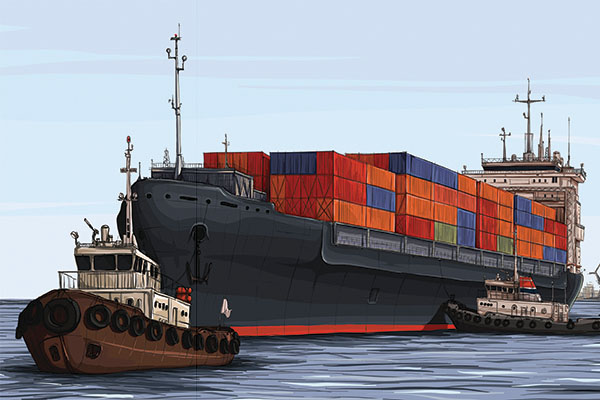U.S.-bound import declines remain intact, reports Port Tracker
Even though improvements are starting to appear, on the heels of a three-year low in February, United-States bound imports, in the coming months into the fall, are expected to remain below 2023 levels, according to the new edition of the Port Tracker report, which was issued today by the National Retail Federation (NRF) and maritime consultancy Hackett Associates.
The ports surveyed in the report include: Los Angeles/Long Beach; Oakland; Tacoma; Seattle; Houston; New York/New Jersey; Hampton Roads; Charleston, and Savannah; Miami; Jacksonville; and Fort Lauderdale, Fla.-based Port Everglades.
Authors of the report explained that cargo import numbers do not correlate directly with retail sales or employment because they count only the number of cargo containers brought into the country, not the value of the merchandise inside them, adding that the amount of merchandise imported provides a rough barometer of retailers’ expectations.
“Consumers are still spending and retail sales are expected to increase this year, but we’re not seeing the explosive demand we saw the past two years,” NRF Vice President for Supply Chain and Customs Policy Jonathan Gold said in a statement. “Congestion at the ports has largely gone away as import levels have fallen, but other supply chain challenges remain, ranging from trucker shortages to getting empty containers back to terminals. We were pleased by recent reports of progress related to the West Coast port labor negotiations but will continue to monitor the situation closely until there is a new agreement ratified by both parties.”
For March, the most recent month for which data is available, Port Tracker noted that import volumes, for the ports covered in the report, came in at 1.62 million TEU (Twenty-Foot Equivalent Units), marking a 5% gain over February—which saw its lowest volume in a month going back to May 2020’s 1.53 million TEU, when several Asian-based factories and U.S.-based stores were closed because of the pandemic—while posting a 30.6% annual decline. This tally trailed a previous March estimate, of 1.68 million TEU, made in the report last month.
Port Tracker issued projections for April and the subsequent months, including:
- April, at 1.73 million TEU, for an 23.4% annual decrease;
- May, at 1.83 million TEU, for a 23.5% annual decrease compared to May 2022’s all-time monthly high, of 2.4 million TEU;
- June at 1.9 million TEU, for a 15.9% annual decrease
- July, at 2.01 million TEU, for a 7.9% annual decrease (which would mark the first time imports are estimated to be that high going back to October 2022);
- August, at 2.04 million TEU, for a 9.9% annual decrease; and
- September, at 1.96 million TEU, for a 3.4% annual decrease
Port Tracker lowered its total forecast, for the first half of 2023, from 10.8 million TEU to 10.4 million TEU, which would represent a 22.8% annual decline. While a full-year forecast has not been issued, it said that the third quarter is pegged at 6 million TEU, for a 7.2% annual decline, with the first nine months of the year estimated to come in at 16.5 million TEU, for a 17.8% annual decrease.
Hackett Associates Founder Ben Hackett wrote in the report that there are a considerable number of economic headwinds facing future import growth prospects, including another bank failure, and the Federal Reserve last week raising interest rates another 0.25%, to 5.25, its highest level since 2007 and the 10th consecutive rate hike going back to March 2022. He also noted that while inflation is coming down, it is happening at a slower-than-expected pace, coupled with another interest rate leading to higher borrowing costs and mortgage costs, as well as slower construction activity, and stalled employment growth.
“Consumers are reacting by spending less and saving more, which is what one would expect, although spending on services remains healthy,” he wrote. “With economic uncertainty continuing, the impact on trade is clear: year-on-year import volumes have been on the decline at most ports since late last year. Declining exports out of China highlight the slowdown in demand for consumer goods. Our forecast now projects a larger decline in imports in the first half of the year than we did last month. Our view is that imports will remain below recent levels until inflation rates and inventory surpluses are reduced.”













